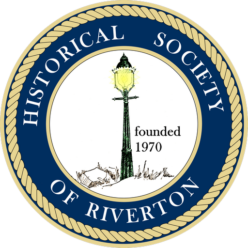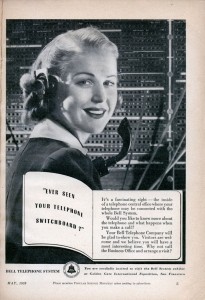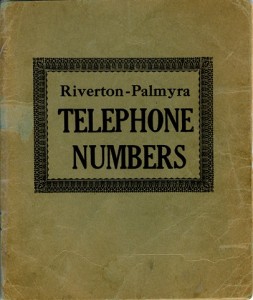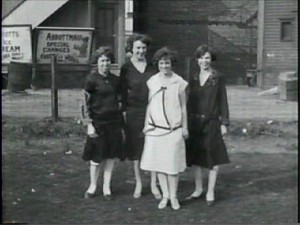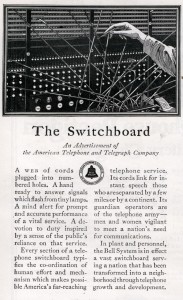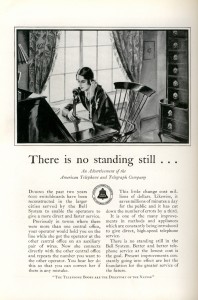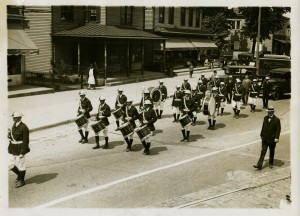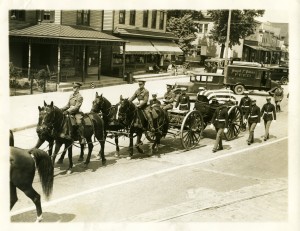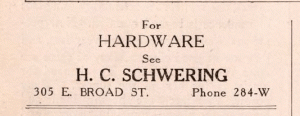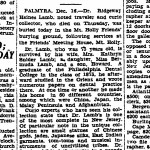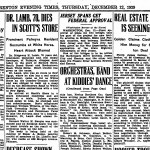
Marge Habernn’s recent donation of a rare 1933 New Era newspaper proves here to be grist for the first of several posts from this blog mill.
Readers of that nickel weekly hometown gazette in the first quarter of March 1933 were no doubt hopeful to receive some good news that would release them from the grip of economic hardships brought on by the Great Depression.
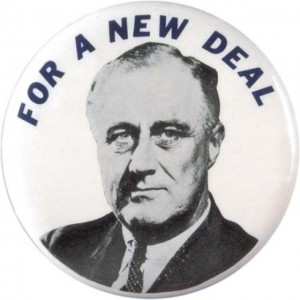 An upbeat editorial titled “American Morale” supported the recent “bank holiday” and remarked on the amazing power given President Roosevelt during this “new deal,” calling it a “great event.”
An upbeat editorial titled “American Morale” supported the recent “bank holiday” and remarked on the amazing power given President Roosevelt during this “new deal,” calling it a “great event.”
Apparently, the Palmyra National Bank was reopening after being put into the hands of a conservator. The article explained that old accounts were restricted— “no checks against them will be honored.” The good news—the bank recorded $33,000 in deposits from Saturday to Tuesday.
Historical note: President Roosevelt had only just assumed the presidency of a nation in economic chaos on March 4. Prior to his taking office, there had been a month-long run on banks. He immediately declared a nationwide bank holiday that shut down the banking system for a week. Congress introduced the Emergency Banking Act of 1933 on March 9 and passed it the same evening. Roosevelt appealed directly to Americans to prevent a resumption of bank withdrawals in his first Fireside Chat on March 12. The following week banks reopened on as depositors stood in line to return their hoarded cash.
Riverton’s slashed tax rate made the front page—down fifty-eight cents to $3.60 from $4.18 the previous year. Borough and school taxes took hard hits, with employees taking a ten percent pay cut. They even pared down the fund for Riverton’s beloved Fourth of July celebrations. The dire situation downstream prompted Palmyra to issue scrip with which to pay teachers and town employees that was acceptable for payment on taxes, sewer fees, and other such borough indebtedness.

Elsewhere in the paper, the Welfare Committee urgently appealed to the generosity of Riverton and Cinnaminson for more funds so that it could aid 133 registered unemployed. They also needed children’s and men’s shoes of every size.(Riverton population would decline during the decade from 1930-1940 from 2483 to 2354, a 5.2% drop)
Things were tough all over, kids.
An ad on page three for the Philadelphia Flower Show was a familiar sign of spring. If one could not live like a millionaire in these tight times, for a 75¢ admission, at least they could go to the Philadelphia Flower Show and see “a million dollars’ worth of fragrant blossoming plants, many in varieties shown for the first time.”
The Philadelphia Flower Show had been a Philadelphia tradition since 1829 when twenty-five Pennsylvania Horticultural Society members showed off their horticultural treasures in a building on Chestnut Street. Billed as “largest indoor flower show in the world,” the Philadelphia Flower Show continues this week at the Pennsylvania Convention Center from Sunday, March 4 – Sunday, March 11, 2012.

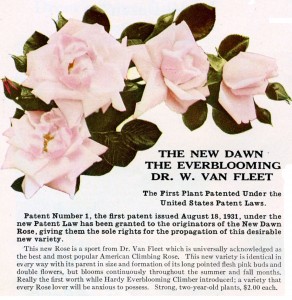
The employees of Henry A. Dreer very likely must have prepared for some time for the upcoming Philadelphia Flower Show. A page two column, “Dreer’s Exhibit at the Flower Show” gave New Era readers an insider’s preview of the elaborate display of water lilies in a pool encircling a piece of statuary and a full 6,000 square feet of space devoted entirely to a garden of Dreer’s famed roses.
Among rose growers, the announcement of a new hybrid was, and still is, a highly anticipated event, even in tough times. The first patented plant in the world was “New Dawn,” introduced by Henry Dreer in 1930. Decades later, the repeat-flowering climbing rose remains a classic choice for gardeners today.
![Mrs. J.D. Eisele Rose Dreer Garden Book 1934, pg 167 [1171x1200]](https://rivertonhistory.com/wp-content/uploads/2012/03/Mrs.-J.D.-Eisele-Rose-Dreer-Garden-Book-1934-pg-167-1171x1200-292x300.jpg)
For the rest of this post, I refer you to what former Riverton Town Historian, Mrs. Betty B. Hahle, wrote for her “Yesterday” column in the December 1977 Gaslight News about the impact of Dreer’s on Riverton. Betty’s column follows exactly as she wrote it 35 years ago.
– John McCormick, Gaslight News editor
Yesterday
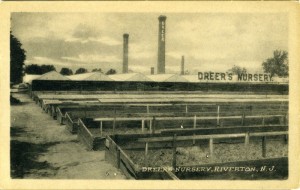
Dreer’s Nurseries in Riverton were known throughout the world. It was founded in Philadelphia in 1838 as a seed and plant farm, prospered and grew, moved, and in 1873 located permanently in Riverton. It became the town’s largest industry, and was instrumental in its development from a tiny resort area to a bustling community of families who built homes and churches and who were active in a large number of clubs and civic organizations.
![Original Calvary Presbyterian Church [1600x1008]](https://rivertonhistory.com/wp-content/uploads/2012/03/Original-Calvary-Presbyterian-Church-1600x1008-300x189.jpg)
The site had been selected 5 years before, influenced by available land, proximity to major cities, and excellent transportation (railroad and boat). It spread northward from Cinnaminson St., on both sides of the railroad, to cover about 100 acres. On the river side of the railroad were greenhouses covering almost 8 acres which, in the early 1900s, required 3000 tons of coal per season to heat. At the same time, 150 men were regularly employed in gardens, packing sheds, and other parts of the Nurseries, and in the busy season the number increased to 200.
Mrs. Dreer presented a pulpit to the Presbyterian church, a memorial to Henry A. Dreer, which both had been instrumental in founding the year after the nursery came to Riverton.
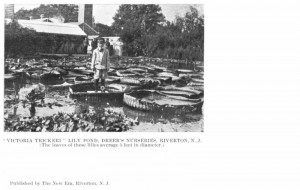
The Nurseries became an integral part of the town. Dreer’s whistle sent many a housewife scurrying to have a meal on the table when her husband or son came home for lunch, and was a dependable check on the old parlor clock.
A leisurely Sunday afternoon found many people, visitors and residents alike, strolling through magnificent greenhouse showrooms of rare specimens from all over the world, or through the rose gardens, where over 500 varieties of standard and hybridized roses bloomed.
![Philadelphia Flower Show medal [768x768]](https://rivertonhistory.com/wp-content/uploads/2012/03/Philadelphia-Flower-Show-medal-768x768-300x300.jpg)
Or to the lily ponds, over 8 acres of them along the creek and on both sides of the railroad, where some specimen plants had pads 6 feet across and could support a man’s weight, and where not only goldfish swam, but also some tropical varieties accidentally imported along with the water plants. In the 1930s it was even possible to fly over the acres of flowers in bloom in a small open plane (remember the little airport on S-17). Helen Van Pelt Wilson illustrated her garden books with pictures taken at Dreer’s Nurseries, and in some of the local gardens. And at the Philadelphia Flower Show, Dreer’s roses were consistent 1st place winners.

After a century of developing improved strains of vegetables, grasses, small fruits, and many flowers and shrubs, Dreer’s Nurseries closed their doors for the last time, during WW II. In less than 30 years the stores, parking lots, houses and apartments and industries that replaced the nurseries have erased it all, making it hard to picture the beauty that was once there. – BBH 1977
(Some inf. from The New Era, Christmas, 1909)
![Dreer rose trial grounds 1932 Garden Book, pg 120 [1600x1015]](https://rivertonhistory.com/wp-content/uploads/2012/03/Dreer-rose-trial-grounds-1932-Garden-Book-pg-120-1600x1015.jpg)
